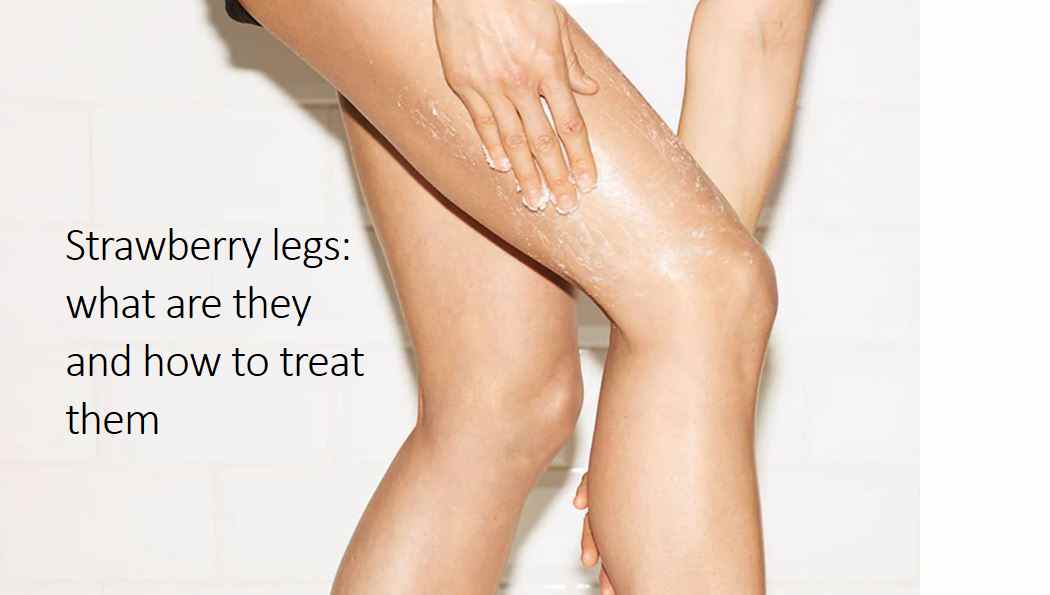Strawberry legs
I have a revelation to make: Not only have I had issues with blackheads and oily T-zones, but I’ve also noticed that my leg pores can darken a bit, leading to this termed “humdinger skin.” chicken” or strawberry legs.
Usually, I wouldn’t mind, as my legs are rarely bare thanks to New York’s eight-month winter, but wearing shorts and long dresses made me feel a little uncomfortable in the summer.
Strawberry legs are just what they appear to be: dark patches or pink dots on the legs that resemble the strawberry’s skin and seeds. According to Debra Jaliman, MD, a dermatologist in New York, these seed-like spots are open pores that harbor oil, dirt, or bacteria after shaving. The medical word for them is keratosis pilaris.
If you’re one of those with strawberry legs, dermatologists share tips and products to help manage the condition.
What Causes Strawberry Legs?
The skin forms a clump of a protein called keratin, the same building block for hair, skin, and nails. The keratin forms a plug that blocks hair follicles, resulting in tiny bumps, elucidated Rachel Nazarian, MD, a New York-based dermatologist and member of the aad.
“The plug also trains inflammation in the skin that sources redness around each hair follicle,” added Dr. Added Nazarian.
In addition, hair follicles can be irritated by sweating and friction. Therefore, wearing loose clothing and keeping your skin cool and dry can help. “Denns Certains cas, des imperfections individual peuvent s’infecter, évitez donc de les toucher cela peut provoquer one irritation and meme of permanent scars,” explained Dr. Joshua Zeichner, Director of Cosmetic Research and Dermatology Clinic at Mount Hospital Sinai in New York.
Keratosis pilaris is most common on the back of the arms, but many people can also get small, hard lumps on their thighs, legs, and even their backs. Folliculitis is an extra condition that can appear similar and begins with inflamed and angry hair follicles on the thighs and legs, added Dr. Added Nazarian.
Both of these conditions are very common and not dangerous, but they can sometimes be itchy or painful. However, people are usually only bothered by aesthetic appearance.
Although it is a genetic condition, we don’t know why some people have keratosis pilaris, and others don’t, Dr. Nazariano. We also don’t understand why it happens in some areas of the body and not others.
The Best Treatments Approved By Dermatologists
Combining strawberry leg prevention strategies and adding the right products to your skincare repetitive can help treat keratosis pilaris if you already have it.
Invest in a good scrub, as ingredients that reduce the appearance of pores can also help treat keratosis pilaris, suggests Dr. draftsman. Look for products that contain glycolic or salicylic acid, which reduce inflammation, unclog pores, and remove dead skin cells.
Dr. Jaliman liked CeraVe SA Cream for Lumpy, Bumpy Skin because it contains salicylic acid to dissolve keratin without irritation gently. Dr. Jaliman was a fan of Glytone Exfoliating Body Lotion, which contains glycolic acid to remove dead skin and help with the uneven texture of strawberry legs.
When shaving, use a gentle cream like Dove Body Mousse and a razor or epilator with fewer blades (two blades is ideal) to avoid further irritation, advised Dr. Nazarian. Follow with a moisturizer with ingredients like colloidal oatmeal or ceramides that help soothe and protect skin by minimizing the appearance of dark spots, said Dr. Illustrator.
Dr. Zeichner recommended Aveeno Skin Relief Moisturizing Repair Cream, which provides all-day hydration and is similarly fragrance-free and non-comedogenic, so it won’t further irritate skin or clog pores.
Topical retinoids are also supportive of keratosis pilaris. According to the AAD, retinoids are vitamin A-based skincare products. They can increase follicle turnover, improve skin tone, and prevent keratin buildup in pores.
What Else Should You Know About Strawberry Legs
“The greatest mutual mistake my patients kind is trying to ‘rub’ the bumps or employing a thick loofah to eliminate the bumps,” speaks Dr. Nazariano. While this technique is a temporary fix, it loosens keratin blockages; harsh exfoliation can further inflame the skin and hair, ultimately leading to redness and making the illness even more visible, Dr. Nazarian further.
The most excellent way to treat keratosis pilaris is to wash the skin with a mild cleanser, pat dry, and apply a cream or lotion daily that contains salicylic or glycolic acid, which dissolves the keratin clogs without further irritating the skin.
Continued use of these creams and lotions will help smooth your skin, curtail redness, and reduce the appearance of strawberry legs over time. However, keratosis pilaris is a problematic skin condition to treat. According to the AAD, Keratosis pilaris is “well-cared for with treatment,” although bumps could reappear if the medication is stationary.
If you find that you still have issues with your skin, consult a dermatologist for help with treatment options.
Also read:Seven Tips To Say Goodbye To Headaches







